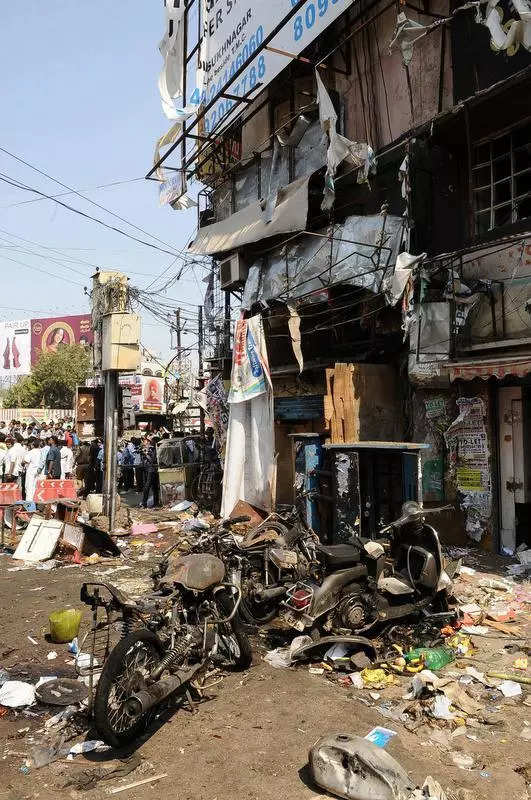HC confirms death to 5 IM operatives for 2013 Dilsukhnagar twin blasts | Hyderabad News

Hyderabad: The Telangana high court on Tuesday upheld the death sentence awarded earlier by a National Investigation Agency (NIA) court to five Indian Mujahideen (IM) operatives for the deadly Dilsukhnagar blasts in 2013. As many as 18 persons were killed in the blasts, which included an unborn child, and left 133 people injured. Some were crippled for life.
The twin blasts took place in the bustling Dilsukhnagar area on Feb 21, 2013. The first explosion went off at a bus stop and the second explosion was less than a minute later near an eatery, AI Mirchi Centre. The NIA had taken over the investigation soon after in March that year.
On Tuesday, a division bench comprising Justice K Lakshman and Justice P Sree Sudha gave the order in the nine-year-old reference made by the special NIA court to confirm the death penalty as well as on the appeal filed by the five convicts against the sentence.
It was on Dec 13, 2016, that the NIA court had sentenced to death the five men – IM co-founder Mohd Ahmed Sidibapa alias Yasin Bhatkal (Bhatkal, Karnataka), Asadullah Akhtar alias Haddi (Azamgarh, UP), Tahaseen Akhtar alias Monu (Samastipur, Bihar), Aizaz Shaikh (Pune, Maharashtra) and Pakistani national Zia-ur-Rahman alias Waqas. The NIA court had held them guilty under various sections of the Indian Penal Code, the Explosive Substances Act, and the Unlawful Activities (Prevention) Act.
The prime accused and alleged blast mastermind Riyaz Bhatkal was never caught or tried. Hence, the trial was conducted against only the five accused in custody.
Challenging the death sentence, the convicts contended that the investigation was faulty. They argued that there were no eyewitnesses linking them to the blasts and that the identification parade of the convicts during the investigation was not conducted as per the procedure.
They also claimed that procedures under different sections of the Evidence Act, UAP Act, NIA Act, and the CrPC were violated. Additionally, they argued that the dying declarations of those who died in the blasts were not recorded.
The high court, while dismissing their contentions, observed that the trial court had examined the evidence, both oral and documentary, which convicted them.
Delivering its verdict, the bench said that all the six accused had acted in tandem to trigger the blasts as part of their criminal conspiracy aimed against the Indian state.
The bench, which went through the record, statements and heard the arguments of both sides, said that there was absolutely no chance of reformation or rehabilitation of the convicts. It held that the trial court’s judgment was based on strong evidence and that the act was “rarest of the rare” and warranted maximum punishment.
“Life imprisonment would be completely futile since the sentencing aim of reformation is completely unachievable. Having given due consideration to all the aggravating and mitigating circumstances, we are of the firm view that this is a fit case wherein the death penalty awarded by the sessions court needs to be confirmed,” the bench said.
The bench also informed the convicts that they have an option of appealing against this order before the Supreme Court within 30 days.
The twin blasts took place in the bustling Dilsukhnagar area on Feb 21, 2013. The first explosion went off at a bus stop and the second explosion was less than a minute later near an eatery, AI Mirchi Centre. The NIA had taken over the investigation soon after in March that year.
On Tuesday, a division bench comprising Justice K Lakshman and Justice P Sree Sudha gave the order in the nine-year-old reference made by the special NIA court to confirm the death penalty as well as on the appeal filed by the five convicts against the sentence.
It was on Dec 13, 2016, that the NIA court had sentenced to death the five men – IM co-founder Mohd Ahmed Sidibapa alias Yasin Bhatkal (Bhatkal, Karnataka), Asadullah Akhtar alias Haddi (Azamgarh, UP), Tahaseen Akhtar alias Monu (Samastipur, Bihar), Aizaz Shaikh (Pune, Maharashtra) and Pakistani national Zia-ur-Rahman alias Waqas. The NIA court had held them guilty under various sections of the Indian Penal Code, the Explosive Substances Act, and the Unlawful Activities (Prevention) Act.
The prime accused and alleged blast mastermind Riyaz Bhatkal was never caught or tried. Hence, the trial was conducted against only the five accused in custody.
Challenging the death sentence, the convicts contended that the investigation was faulty. They argued that there were no eyewitnesses linking them to the blasts and that the identification parade of the convicts during the investigation was not conducted as per the procedure.
They also claimed that procedures under different sections of the Evidence Act, UAP Act, NIA Act, and the CrPC were violated. Additionally, they argued that the dying declarations of those who died in the blasts were not recorded.
The high court, while dismissing their contentions, observed that the trial court had examined the evidence, both oral and documentary, which convicted them.
Delivering its verdict, the bench said that all the six accused had acted in tandem to trigger the blasts as part of their criminal conspiracy aimed against the Indian state.
The bench, which went through the record, statements and heard the arguments of both sides, said that there was absolutely no chance of reformation or rehabilitation of the convicts. It held that the trial court’s judgment was based on strong evidence and that the act was “rarest of the rare” and warranted maximum punishment.
“Life imprisonment would be completely futile since the sentencing aim of reformation is completely unachievable. Having given due consideration to all the aggravating and mitigating circumstances, we are of the firm view that this is a fit case wherein the death penalty awarded by the sessions court needs to be confirmed,” the bench said.
The bench also informed the convicts that they have an option of appealing against this order before the Supreme Court within 30 days.
















